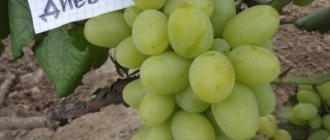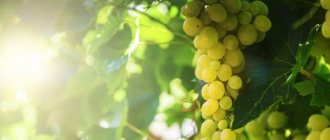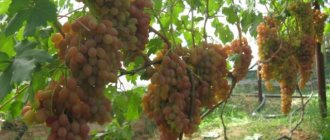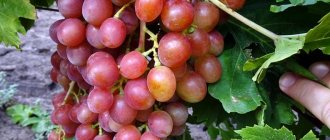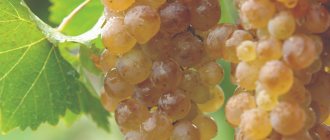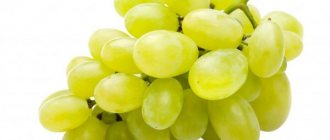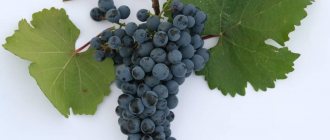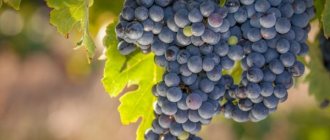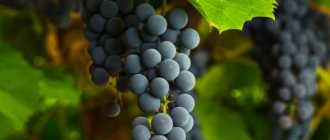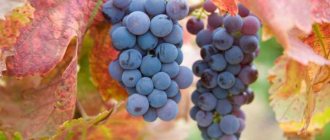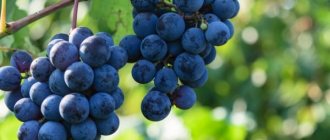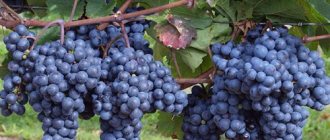Advantages and disadvantages
Pros:
- Frost resistance.
- Early onset of fruiting.
- Resistance to diseases and pests.
- Uncovered hybrid.
- Good survival rate.
- High yield.
Minuses:
- Rapid growth - up to 2 m per season.
- The need to plant male and female plants for fertilization.
- The need for pollination by insects.
- Abundant foliage.
History of creation
According to various sources, the history of the creation of the hybrid is different. According to some sources, “amethyst” was introduced by crossing wild grapes growing in the Volgograd region with varietal crops. The author of the hybrid is A.I. Potapenko. Initially, wild grapes were crossed with “Tsimlyansky black” and “Amur”, then the resulting hybrids were again crossed with “Amur”.
Parents of “Amethyst”
According to other sources, the hybrid has three varieties, obtained in different ways:
- “Amethyst Novocherkassk” - was bred in 2009 by A.I. Potapenko in the city of Novocherkassk, Rostov region, when crossing the varieties “Delight” and “Red Delight”.
- “Samara amethyst” - was obtained by crossing “Hamburg nutmeg” and “early ripening Kuibishevsky”. V. Paltseva, P. Merkulova and N. Kazakova worked on its selection.
- “Super-early amethyst” was developed in the early 2010s and is currently the object of study, since its characteristics have not been fully identified. P. Golodriga worked on its creation. The parent varieties are “Antey Magarachskiy” and “Tavriya”.
Main characteristics
| Variety | Amethyst Novocherkassk | Amethyst Samara | Amethyst Super-early |
| Ripening time | 90-110 days (end of August – beginning of September) | 90-110 days (end of August – beginning of September) | 70-90 days (August) |
| Bush | Tall, preferred shape - fan | Medium height up to 1.5 m, hermaphroditic flowers | Medium height up to 1.5 m, flowers bisexual |
| Bunches | Cylindrical, elongated, medium density, weighing 600-800 g | Elongated cylindrical, weighing 200-300 g, dense on a short stem | Dense, elongated, weighing up to 1.5 kg |
| Berries | Dark pink, purple-red when ripe, overripe - crimson, average weight - 6-8 g | Ripe berries are purple or pinkish, with a waxy coating and elastic skin, with seeds | Ripe berries are lilac to violet in color, oval or elongated, thin skin, with seeds |
| Taste characteristics | Harmonious taste reminiscent of plum | Simple, without nutmeg | Simple taste with a rich nutmeg aroma |
Features of cultivation
To obtain the planned harvest, it is necessary to properly care for the grapes: trim them on time, carry out preventive spraying and cover for the winter, if necessary.
Trimming
Important! Plants in their first year of life should not be pruned.
Basic pruning is no different. As with most varieties, it is carried out in the fall, leaving 4-6 eyes on the vine. Young side shoots more than 15 cm long are pruned to 3-4 cm. In the spring, shoots and stepchildren damaged by frost are pruned.
Diseases and pests
All three hybrids in general are highly resistant to diseases and pest attacks. They are most susceptible to the following diseases:
- Oidium is a fungal infection, the signs of which are a powdery coating on the leaves and vines, dark spots with the smell of rotten fish.
- Gray rot is a fungal infection characterized by the appearance of a fluffy gray coating on the underside of leaves. The spread of infection leads to drying out and death of the vine.
- Mildew - characterized by the appearance of pale spots on the leaves that are greasy to the touch. The causative agent is also a fungus.
For control and prevention, the drugs Efal, Mikflom, and iron sulfate are used.
Reference! Depending on the subspecies, hybrids are also susceptible to varying degrees of chlorosis, anthracnose, rubella and bacterial cancer.
Frost resistance
All three are resistant to temperatures down to -35 degrees. Adult plants do not need shelter if they have been accustomed to the cold from the moment of planting.
The annual vine is wrapped for the winter, and it must be covered no later than the end of September.
The vine of the second year of life is covered later and the cover is removed earlier.
If there is no damage from the cold, then by the fourth year of life the grapes are left without shelter.
Storage
All three varieties can hang on the vine for a long time without overripening - up to 2 months , but this delays the ripening of new bunches. The hybrid's high transportability is also noted.
After removing the bunches from the vine, long-term storage is undesirable; fresh consumption or processing into juices, wines, jams, etc. is recommended.
Regions
Hybrids are cultivated in the central regions of Russia, the Volga region, Siberia, and southern regions. In addition to Russia, it is also grown in Ukraine and Belarus.
Reference! The Novocherkassk Amethyst harvest begins at the end of August. The variety is transportable - the berries do not wrinkle or drip.
Landing
Plant in spring in a sunny place (depending on the region - at the beginning or end of May), the distance between seedlings = 2 m in diameter.
Advice: it is better not to plant fruit trees or shrubs near grapes, as they retain snow.
At the bottom of the planting pit you need to put crushed stone or brick, and on it earth mixed with humus (up to 10 kg), potassium, nitrogen, and phosphorus salts. Hill up the seedling with the same mixture a few centimeters.
Advice : install a stake to tie subsequently growing shoots.
In a few days, roots and new shoots should appear. Then the seedlings need to be unplanted.
Comparison with analogues
“Amethyst” belongs to the group of Amur grape varieties. They all have similar characteristics and are very frost-resistant. Let's look at a few of them in a comparative table.
| Sign | Variety | |||
| Amethyst | Amur breakthrough | Levokumsky | In memory of Dombkowska | |
| Ripening period | 100-110 days | 110 days | 115-125 days | 115 – 120 days |
| Frost resistance | up to -29°C | -40C | Up to -40 °C | -30C |
| Yield per bush | 6-10 kg | Up to 100 kg | 4-7 kg. | From 12 kg to 20 kg |
| Bunches | up to 0.9 kg | 200-400 g | 100-150 gr. | From 300 g to 1 kg |
| Taste | nutmeg | Simple, harmonious | Balanced | Sweet taste with slight sourness |
| Color | lilac to dark purple | Dark blue | Dark blue | Issinya - black |
| Disease resistance | average | High | Average | Average |
| Shelf life | up to 3 months | Up to 1 month | A few days | Up to 2 months |
| Sugar content | 16-23% | 23% | 22% | 20% |
| Acidity | 5-7 g/l | 6 – 7 g/l | 7-9 g/l | 10 g/l |
Forum statistics
207036 Messages in 1634 Topics from 5593 Users. Last user: Amaya Last message: “Let's talk about the weather in Vash...” ( Today at 07:52:22 ) Latest messages on the forum.
Now on the forum
42 Guests, 8 Users
Users in the last 15 minutes: 64nikolay64, GALINA ANOKHINA, Yura, zsb, Polina77, spotlight, Mikhail Alekseevich, Svetla777 [Blocked] [Section Moderator] [Forum Moderator]
Maximum online today: 77 . All-time maximum online: 2758 (28 July 2021, 17:22:51)
Users who visited the forum in the last 24 hours
Total: 293
(Visible: 292, Hidden: 1) 1963, 64nikolay64, GALINA ANOKHINA, Yura, zsb, Polina77, spotlight, Mikhail Alekseevich, Svetla777, Quiet, Marshal, Nikolay S., therapist, Liza, Capricorn, lomakin1969, Alexander Vl., Elvira2017 , Andrey76, Slavka, Mikhail77, ElenkaF, Tatyana B, Alex65, Cherkessk, Eugene, leonidych, vladimirM, yotmast, mers, Serg1707, SNovichek, hanter64, znakomij, Alexander K, Vardan, Sergey Fer, Anatoly Sivkov, Alexey V, Ilya 77 , Andrey Gladilin, Tatyana A., Belgorodets, in Astrakhan, Oksana Kopp, sem_en, Vladimir 153, skier, Igor Viktorovich, slavalimon, Primorets, OlgaOs, SANYCH, 31rus, mystic69, DorontsovPeter, Andrey Tsvetkov, Buba, igor222, Elena Z, vlad51, Kenig, Nikolay Rex, Sergey 1965, Vladimir Buturlakin, DSW, psv1960, Dmitry 77, Vasily V., Vyacheslav03, Natalia Nikolaevna, Sergey Tashchiyan, Igor Sergeevich, alexsandr, kvg, Pioneer, Ekaterina Polyanina, nicson7, Elena Aleshchenko, Alexander -ask-34, Verona, Igor F., Taker, Henry, Yuri72, L.A.P., Gaivoronsky Yuri, Sergeevich, Sergei Chistokletov, Svetlana Streletskaya, Galinka, Alexey Deminov, Naumov Igor, Vyacheslav136, Gloomy, Katrin, AndSanych , Mikhno Alexander, Ded31, Filippov Oleg, Vladimir ++, Lydia58, ALEXANDER BRYANSKY, Vladimir-kanevskaya, DIL, Amber7394, Marina Protasova, TITOVA LYUBOV, Linx, alexander66, Natalya M, Mikhail Fesenko, Amaya, Alexander71, Boris 1952, tsv , Maximilian, 25nata35, nadia, Igor_K, Alexander Kolesnikov, Ivan Levin, Pitko, weather forecaster, eSAa, cecet71, atseton, Alexander Smirnov, Vladimir Kostochkin, Vladimir Berdnikov, Gocha, pioneer-2, LeXa_KoT, Sergey 61, Sergey Yuryev, Erem, alexss, Evgeniy52, Skif, Vladimir Kovba, dayton, Yuri Semenov, N.A. Sokolov, Pavlentiy, Sa-shura, Volgogradka, Dmitry Anatolyevich, Grandfather Igor, Andrey Lis, Bublichenko Alexander M, Marina Krymskaya, stenlly2010, irahelm, Vyacheslav Vladimirovich , Vladimir Shilov, Aprel, Dmitry Badaev, gheo55, y_fed, rambo, Yagodka, Valentina Ivanovna, Kryn, oleg9f, DED2, Svetlana Korotina, Oleg Ivanovich Zavezen, Eduard., santra, L2k2m7n, Alexander48, Viknik, Andrey 31, m2d, Valery Rastorguev, Soshnin Yura, Gardener - amateur, Galina, Vasily1111, gardener, marlin64, Salex, sergei, Sergey Ko, Ramiz, Victor_, kosmos, potap05, Yuri 36, VitalySD, Inna161, Vova Kapran, Vladimir Shcherbinin, Valerie, niy1, cfibr , Andrey68, kulol3, thanatos, Serzh1978, Realist, Artur53, max2008-01, LOZA, AlexanderD, Grandfather Young, Natasha, Zayac, ketch, Rita, alx-74, Iv Iv, Alexander150, Igor K, Vasily Viktorovich, VeraNiK, kdm57 , Veniaminovich, Boris Sokolyansky, 77volt, , vikbublik, neposny, Evgen, Victoria Aleksandrovna, Serezha 64, Wintel, Airbone, teri, Sergey Lomonosov, Khramov, serginio, Leonty Yarygin, Irina O., Ser, Nadezhda Grig, Lyubov S., netolya, Saisan, Alexey Agryzkov, Vadi, Zinaida, Vadim, Alexander Taganrog, Sergey Sukhonos, Snezhinets, evgen_26, nau_63, Masha_sadovod, Gennady163, krasnovlad1, Alexander Zinoviev, Vasily 53, Roman Fedorovich, TIS, Alexey Sergeevich, arnyusha, Zheka, Nurtas , kradievska, nick041, Valentina Medvedeva, Sergey43, Andrey S., Nikolay Lipunov, Mst, Vertuoz2, Vladimir VS, NatalyaMed, freesia, Kinna, Mikhail Michurinsk, alekcsan1, VALERY TAMB, Sasha57, MikhAf, Y_Azer, Andrey Beribesov, hunter1955, amateur nuts, Keys, Ivan Shmelev, Pestle, anton_slash, Nadymchanka, Sergey 31, Volgar, Pavel 64, Tatyana Volzh, Elektronik_t, Alexander 61, Alexander Gai
Reviews
A friend gave me a couple of cuttings of Amethyst. I have always wanted to grow grapes, but in our climate it is very problematic - severe frosts, long winters, return frosts in early summer and the first snow in mid-September. The amethyst one took root perfectly, never froze, and after 3 years it produced a good harvest. Svetlana, Barnaul
In our harsh climate, you can only dream about your own grapes. I solved the problem by planting the Amethyst variety on the plot. The bush was quite large, with a closed root system, so already in the first year it showed several small tassels. The taste cannot be compared with grapes from the southern regions, but still very tasty. Tatyana, Magnitogorsk
Among several grape varieties, I always recommend Amethyst to my friends. It does not need to be covered, it has a powerful bush with large wrinkled leaves, full clusters and berries of very good taste. In the 5 years that I've had it, it only froze once, but it quickly recovered. Victor Pavlovich, Nizhny Novgorod
All three “amethyst” hybrids produce consistently high yields, are among the first to bloom, and have good taste. If you follow agricultural techniques, you can get up to 10 kg of harvest from one vine.
Subtleties of care
Amethyst grapes are unpretentious in care and require moderate watering, loosening the soil and removing weeds, adding nutrients and pruning. The agricultural technology is the same for the Samara and Novocherkassk hybrids.
At the initial stage of seedling development, weeding is carried out regularly, since greenery draws nutrients from the soil.
After the foliage appears, the soil around the seedlings is loosened and 10 cm of surface roots are removed to strengthen the root system. The procedure is carried out twice - in June and in August.
In June, pruning is carried out - out of 3-4 shoots, 1-2 of the strongest ones are left, the rest are removed. In the fall, 80% of the branches that appeared in the summer are removed, along with those that bear fruit, are diseased, damaged and weak.
Novocherkassk Amethyst needs pruning of the vine into 4-6 buds. The optimal load is 30-35 eyes per bush.
The frequency of watering young seedlings depends on the presence of mulch under the crown. Mulching allows you to reduce the number of waterings to once every 2 weeks and retain moisture in the soil. Without mulch, plantings are watered weekly. 10 liters of water are poured under 1 bush. Simultaneously with watering, fertilize with nitrogen and superphosphate.
Description of the Molodezhnaya cherry variety: characteristics, reviews, photos, planting and care
In the fall, watering the Novocherkassk hybrid is stopped, and the plant is given the opportunity to independently prepare for wintering.
The situation is completely different with Amethyst of Samara. The plant needs preparation and shelter for the winter. In the fall, after harvesting, water consumption is increased to 60 liters per bush. Pruning is performed 2 weeks after leaf fall.
With the arrival of the first frosts, the plant is covered with agrofibre, dense polyethylene, spruce branches, leaving a gap for air circulation and preventing the bushes from rotting.
Adult plants are watered according to the following scheme:
- in early spring, before the buds swell;
- in May, before flowering and after the formation of ovaries;
- in July, during the formation of berries.
Young shoots are tied to a trellis until the leaves appear. To do this, use natural fabric or rope. The shoots do not overtighten. It is not recommended to use fishing line and wire. The branches on which the brushes will appear are bent down, the remaining shoots are allowed to grow vertically.
Annual seedlings are fed twice a season:
- 20 g of nitrophoska per 10 liters of water at the root at the beginning of active shoot growth;
- 20 g of superphosphate, 15 g of potassium per 10 liters of water at the root in July.
Fruiting bushes are fed three times a season:
- in the second ten days of May before the buds open - 20 g of ammonium nitrate per 10 liters of water at the root;
- during the formation of ovaries - 15 g of nitrogen, 20 g of superphosphate per 10 liters of water under the root;
- after the berries have acquired their final color - 80 g of superphosphate and 35 g of potassium sulfate per 10 liters of water at the root.
Before flowering, foliar feeding is carried out - 40 g of urea, 100 g of superphosphate, 50 g of potassium sulfate, 5 g of boric acid per 10 liters of water. The resulting solution is sprayed on the leaves in the evening or in cloudy weather.
